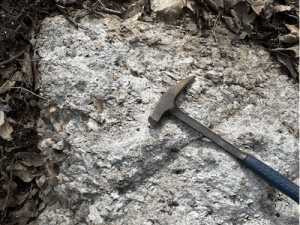By Katie Whittington
North Carolina’s Promising Future in Lithium
North Carolina is at the center of one of the most rapidly growing industries worldwide: lithium. Impacting everything from iPhone battery life to electric vehicle production, lithium is regarded by many as the “chemical of the future.” For hundreds of millions of years, the alkali metal has been calling the Carolina Tin-Spodumene Belt in western North Carolina home. Adam Curry and Drew Coleman are working at the center of this modern boom in lithium exploration research, analyzing everything from the deposit’s geochemistry and formation patterns to its temporal patterns and life span.

Both Coleman and Curry’s projects take an innovative approach to increasing efficiency in lithium extraction and exploration. With fieldwork based in western North Carolina, Professor Coleman seeks to “pinpoint where we’re more likely to find more of the good stuff,” by understanding rocks’ ages and how they are correlated with concentrations of lithium. “They’re very strange rocks,” Coleman remarked. There’s “conventional wisdom” regarding how they form, but no conclusive research.
Professor Curry’s studies are “complementary” to his colleague and longtime friend. Focusing on the petrogenesis – the rock formation – of lithium, Curry hopes to increase the efficiency of lithium exploration by identifying key minerals in the rocks and seeing how this varies across the belt. With this knowledge, exploration and extraction efforts can be streamlined, focusing on areas with high lithium concentrations.
With increased efficiency in exploration comes easier extraction, and with easier extraction comes localized processing and manufacturing centers. Currently, lithium travels thousands of miles from extraction sites – many of which are in Australia, Africa, and South America – to processing plants and then to manufacturing centers. This produces a massive carbon footprint. However, with a North Carolina-based lithium industry, the carbon footprint associated with producing an iPhone battery could be massively reduced, according to Curry. Coleman added, “North Carolina is poised to have [a] huge impact on the lithium battery industry,” given the high concentrations of lithium-rich rocks along the Carolina Tin-Spodumene Belt.
“North Carolina has the promise and the potential to do it right for the environment as well as the people in the area. It’s a win-win.”

Additionally, lithium can be recycled, bolstering its appeal as a sustainable material. Unlike other elements, like combustible hydrocarbons, “lithium is always going to be lithium,” Coleman said. When hydrocarbons are pulled from the ground and combusted, they become carbon dioxide or water and can no longer be reused in their original form. Lithium is different. Companies like Piedmont Lithium and Albemarle can recycle the element for future use in products like batteries. By keeping lithium processing and manufacturing local, “North Carolina has the promise and the potential to do it right for the environment as well as the people in the area,” Coleman said. “It’s a win-win.”
“I’ve been a geologist since I was six years old,” Coleman said after placing a rock (that he’s had since childhood) firmly on his desk. While he has been studying geology and critical mineral resource exploration for years, his interest in lithium was “purely accidental because of the pandemic.” During the height of the COVID-19 pandemic, Coleman had to shift his research to focus on North Carolina-specific issues because students were unable to leave the State for public health reasons. Lithium seemed like the perfect pivot, given North Carolina’s high concentrations of the chemical.
Like Coleman, Curry is also a long-time geology scholar. After a summer internship in Hawaii studying volcanoes, he exclaimed “Whatever major you can offer me was not as cool as lava.” Coleman added that they have been working together “since Adam was a puppy.” Before their time at the Collaboratory, Coleman served on Curry’s graduate school committee. And, Curry was introduced to the Collaboratory by Coleman. The two researchers each worked on independent projects, and it was purely by chance that they both pursued studies on lithium exploration.
Beyond their research field trips to lithium mines in western North Carolina and shared data samples, Coleman and Curry are also good friends. Their camaraderie was evident even after spending just a few minutes talking with the pair. After a quippy debate about whether UNC-Chapel Hill or NC State has worse parking infrastructure, they both heralded the working relationship they share. The pair agreed that their research fits together like pieces of a puzzle. Theories on mineral formation depend on both temporal and geochemical aspects of rock formation, the focuses of Coleman and Curry’s respective projects.

As they continue working together Coleman says they are “keeping an eye on the data every step of the way” on their corresponding projects. “I love what I do,” Coleman says. “It was just an accident that I got involved with lithium. It’s been fun to get together and work with Adam again.” Moving forward, their research holds the possibility to yield valuable findings for the lithium industry in North Carolina. Until then, you can find the duo exploring western North Carolina with the rocks they have collected since childhood and the friendship they have cultivated for over a decade.
Katie Whittington is a junior studying public policy with minors in sustainability studies and musical theatre. Katie has been an intern with the NC Collaboratory since the spring of 2024.
